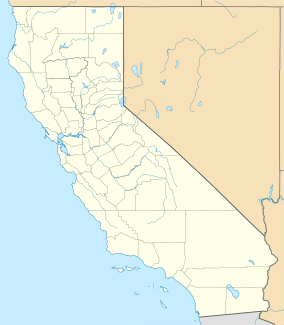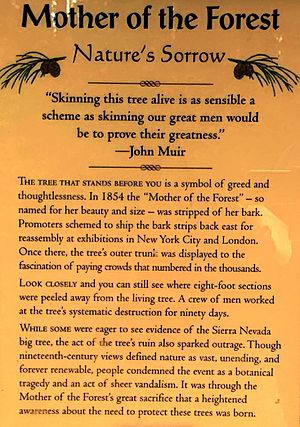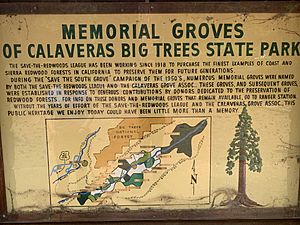Calaveras Big Trees State Park facts for kids
Quick facts for kids Calaveras Big Trees State Park |
|
|---|---|

Giant sequoias in Calaveras South Grove
|
|
| Location | Calaveras and Tuolumne counties, California, United States |
| Nearest city | Arnold, California |
| Area | 6,498 acres (26.30 km2) |
| Elevation | 4,560–4,920 ft (1,390–1,500 m) |
| Established | 1931 |
| Visitors | more than 250,000 (in 2022) |
| Governing body | California Department of Parks and Recreation |
Calaveras Big Trees State Park is a special state park in California, United States. It protects two amazing groups of giant sequoia trees. These trees are some of the biggest living things on Earth!
The park is located about 4 miles (6.4 km) northeast of Arnold, California. It sits in the middle part of the Sierra Nevada mountains. People have been visiting this park since 1852. It's known as the longest-running tourist spot in California.
Contents
History of the Giant Sequoias
How People Found the Big Trees
Long before Europeans arrived, Native American tribes already knew about the giant sequoias. They had their own names for these huge trees, like Wawona and hea-mi-within.
The first time a European wrote about the Calaveras giant sequoias was in 1833. An explorer named J. K. Leonard mentioned them in his diary. But this discovery wasn't shared widely.
Later, in 1850, John M. Wooster carved his initials into a tree called 'Hercules'. Still, no one really knew about these trees outside the area.
The "Discovery" and What Happened Next
The big news came in 1852 when Augustus T. Dowd saw the trees in the North Grove. This is often called the "discovery" of the grove and the giant sequoia species.
One famous tree, the "Discovery Tree", was found by Dowd in 1852. Sadly, it was cut down in 1853. This left a huge stump and a piece of its trunk. The tree was 25 feet (7.6 m) wide at its base. It was about 1,244 years old when it was cut.
A part of the trunk was shown around, and the stump was even used as a dance floor! The famous nature writer John Muir was very upset. He wrote an essay called "The Vandals Then Danced Upon the Stump!" to criticize cutting down the tree.
In 1854, another tree called the "Mother of the Forest" had its bark removed. This was done so the bark could be put back together for exhibitions. Taking off its protective bark badly hurt the tree. It died soon after, losing all its leaves by 1861.
In 1908, a fire swept through the area. Since the tree no longer had its fire-resistant bark, much of it burned away. Now, only a burnt snag (a standing dead tree) remains.
The park also has what's left of the "Father of the Forest." This was an ancient, enormous giant sequoia that fell centuries ago. Its remains are still in the park. People say it was 435 feet (133 m) tall and 110 feet (34 m) around.
In the early 1880s, a tunnel was cut through a living tree. This was done for tourists to walk through. This tree, called the Pioneer Cabin Tree, was chosen because it already had a large fire scar. It was meant to be like the famous Wawona Tree tunnel in Yosemite.
Saving the Big Trees
When people started cutting down and showing off the big trees, many were very upset. In 1864, a senator named John Conness said that even after seeing parts of the "Discovery Tree," people still didn't believe how big these trees were. He felt these areas needed protection.
By the early 1900s, lumber companies owned the land. They planned to cut down the remaining trees for wood. This caused a huge outcry from locals and conservationists. People wanted the area to stay a tourist attraction.
A long fight began to save the trees. Finally, in 1931, the North Grove became part of California State Parks. Over the years, more forest land was added to the park. This included the much larger South Calaveras Grove of Giant Sequoias. Today, the park covers over 6,400 acres (2,600 ha). The North Grove has about 100 mature giant sequoias, and the South Grove has about 1,000!
Why Fire is Important
Fire is super important for giant sequoias. It's one of the most natural things that happens in their forest. Tree rings show that small, frequent fires used to happen all the time for thousands of years. But after about 1860, fires became less common. This was because Native Americans stopped setting fires, and then government agencies started stopping all wildfires.
Now, park crews use controlled fires, called prescribed burns. These controlled fires help the forest stay healthy and make it stronger against bigger, uncontrolled wildfires.
Amazing Attractions
The North Grove has several famous giant sequoias:
- Discovery Tree: This is the stump of what was once the park's largest tree.
- Mother of the Forest: Only a burnt snag remains of this tree, which was the park's second largest.
- Pioneer Cabin Tree: This giant sequoia had a tunnel cut through it. Sadly, it fell during a storm in 2017.
- Empire State: This is the largest living tree in the North Grove. It measures 30 feet (9.1 m) wide at the ground!
The South Grove also has some incredible giant sequoias:
- Louis Agassiz: This is the largest living tree in the Calaveras groves. It's 250 feet (76 m) tall and more than 25 feet (7.6 m) wide. It's one of the biggest giant sequoias in the world!
- Palace Hotel Tree: This is the second largest living tree in the Calaveras groves. It has a huge burn scar at its base that you can walk into.
Other cool spots in Calaveras Big Trees include the Stanislaus River, Beaver Creek, the Lava Bluff Trail, and Bradley Trail.
Fun Activities
The park has two main campgrounds with 129 campsites. There are also six picnic areas and hundreds of miles of trails for hiking.
You can also enjoy cross-country skiing in winter, evening talks by park rangers, and many educational programs. There are junior ranger programs for kids, hiking, mountain biking, and bird watching. Dogs are allowed in certain areas like picnic sites and campgrounds if they are on a leash. However, dogs are not allowed on the main hiking trails.
How to Visit
The park is open all year round. The main road inside the park closes during winter. But the North Grove Area is still easy to reach in winter. There are no public buses to the park. The closest bus stop is in Arnold, California. You can also get to the park by walking, biking, snowshoeing, or cross-country skiing on Upper Moran road.
Images for kids












